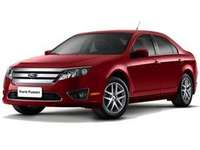New Ford Fusion Redefines Midsize Sedan Expectations with Unprecedented Suite of Driver Assist Technologies
 |
DEARBORN, MI--May 10, 2012:
- All-new 2013 Ford Fusion will be first midsize family sedan in America available with such a wide array of driver assist technologies, including Lane-Keeping System with Driver Alert, adaptive cruise control and collision warning, and active park assist
- These technologies form the basis for Ford's research and development of future personal mobility solutions, including autonomous assist driving capabilities
The all-new 2013 Ford Fusion leapfrogs the Toyota Camry and Honda Accord with an unprecedented suite of active driver assist technologies usually found only in luxury cars costing twice as much.
A package of radar, ultrasonic, optical and motion sensors adds a new level of convenience for midsize sedan customers by transitioning beyond passive safety technology to offer drivers Lane-Keeping System, Driver Alert System, Blind Spot Information System (BLIS), active park assist, cross-traffic alert, adaptive cruise control, collision warning and a rear view camera.
"These new sensing technologies help extend the driver's own senses, providing a level of assistance never before available to the family sedan buyer," said Adrian Whittle, Ford Fusion chief engineer. "The new Fusion launches this year with these advanced technologies -- making them more affordable and available than ever before."
Fusion's suite of driver assist technologies are the result of the addition of new sensors, including cameras and radar combined with existing technologies, such as electric power-assisted steering (EPAS) and data from the anti-lock braking and stability control systems.
Lane-Keeping System
Lane-Keeping System uses a forward-facing camera that can scan the road surface for lane markings. The Lane-Keeping System can evaluate if the car is drifting out of its lane and then alert the driver by vibrating the steering wheel. If the driver does not respond to the vibrations, the system provides steering torque to nudge the car back toward the center of the lane.
To view video about the Lane-Keeping System, click here: Youtube
Driver Alert System
Driver Alert uses the front-facing camera to detect a pattern of vehicle motion consistent with a drowsy driver, and provides a series of alerts to suggest the driver stop and rest for a while. The visual alert includes a coffee cup icon appearing in the instrument cluster display indicating that pulling off the road and taking a break is a good idea. In a survey conducted by AAA Foundation, more than 40 percent of Americans acknowledge they have fallen asleep or nodded off while driving.
Pull-Drift Compensation
Pull-Drift Compensation is built into the electric power-assisted steering to counter the effects of steeply crowned roads or steady crosswinds. It can detect if the car is changing direction even if the steering angle sensor indicates the driver is not commanding this change. The Pull-Drift control then uses EPAS to provide gradual steering corrections that keep the car moving to where the driver wants to go.
Adaptive cruise control with collision warning
Adaptive cruise control uses a radar sensor that measures the distance and speed to the vehicle ahead.
With this extra information, the same engine power reduction and brake application techniques that are used to limit wheel spin by the traction control system can now be used to automatically slow the car and maintain a safe following distance when the adaptive cruise control is active. If the sensors detect the following distance is shrinking too quickly and a collision is likely, the system will provide a visual and audio alert so the driver can respond by steering or braking.
Active park assist
With available active park assist, the electric power-assisted steering and ultrasonic sensors at the corners of the car work in concert to help make parallel parking a breeze. The sensors measure the gap between parked cars to see if there is enough room, and then the car is automatically steered into the space. The driver just has to apply the accelerator and brake.
Blind Spot Information System with cross-traffic alert
No matter how careful drivers are, the physical constraints of sitting inside a car means there always will be places they cannot see. Rearview mirrors help, but the Fusion is available with radar sensors in the rear corners that can monitor the spaces beside and just behind the car.
On the road, these sensors trigger a warning light in the mirror indicating there is another vehicle in the blind spot the driver may not be able to see when changing lanes. When backing out of a parking space, these same sensors can see vehicles coming down the aisle while the back-up camera provides a view directly behind the rear bumper.
What's next?
The driver assist systems in the new Fusion mark Ford's near-term next steps in the development of future mobility technologies. Sensing systems similar to what will be installed on the new Fusion are the foundational hardware that will help further progress active safety technology in the future including autonomous assisted driving in the long-term.
"The new Fusion is a showcase of how we will use sensors and vehicle data to enhance the driver's own capabilities when behind the wheel," said Paul Mascarenas, chief technical officer and vice president of Ford Research and Innovation. "Driver assist technologies will continue to provide increasing levels of convenience in the near-term. In the future, they also will help us manage issues such as traffic congestion and CO2 reduction."
At the recent Mobile World Congress in Barcelona, Spain, Bill Ford, executive chairman of Ford Motor Company, outlined the company's Blueprint for Mobility that presents the development cadence for future active safety systems including vehicle-to-vehicle communications and autonomous assistance technology.
To listen to the speech, click here: Mobile World Live.
The story behind the new Fusion
For more on the new Ford Fusion, check out Ford Fusion Story, a special mobile site featuring articles, videos and graphics that are easily shareable directly from a smartphone, tablet or computer browser to Facebook, Twitter, Google+ and blogs.


